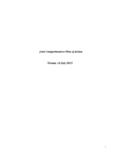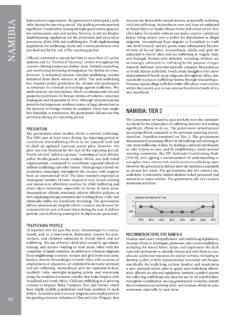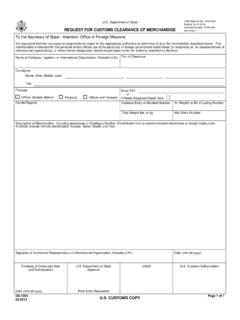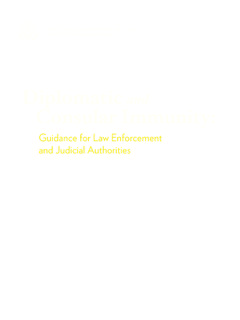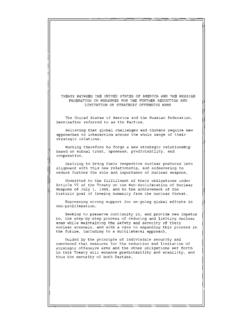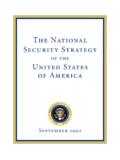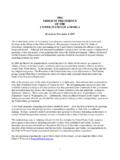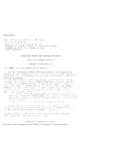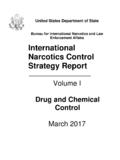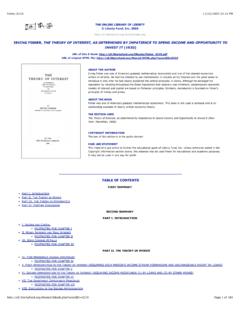Transcription of Introduction to Leahy Vetting Policy
1 Version PP410 Introduction to Leahy Vetting Policy , Version 2 PP410 Introduction to Leahy Vetting Policy , Version 3 Welcome Welcome to the Introduction to Leahy Vetting Policy course. This course provides the background, legislative history, and policies for the Leahy law implemented through the State Department (State) and the Department of Defense (DoD), which govern Vetting of foreign security forces before they can receive various types of government (USG) aid. We strongly recommend completing this course before requesting an account for the International Vetting and Security Tracking-cloud (INVESTc) system, which is the primary workflow management tool and official system of record for Leahy Vetting at State and DoD.
2 While the INVESTc system is largely intuitive, additional support documentation and training are available in the form of context-specific help, printable quick guides, and role-specific training within the application. In-person ( only) and virtual instructor-led training (at post) are also available. Audience This course is designed for direct-hire USG employees and contractors who are involved in implementing Leahy -applicable assistance for foreign security force personnel and units ( , military, police, etc.). PP410 Introduction to Leahy Vetting Policy , Version 4 Course Objective At the completion of this course, you will be able to: Identify the Leahy laws and policies that are the basis of the Vetting process. Course Information Course Structure This course comprises two modules with review questions at the end of the course.
3 To reinforce your mastery of the material, please answer the review questions. Intranet Links This course provides useful links to the Department of State intranet. You must use a Department of State OpenNet computer to view all intranet sites. Review Questions The review questions are intended to test and reinforce your learning. Question types used in the review may include true/false, multiple choice, and multiple answer questions. PP410 Introduction to Leahy Vetting Policy , Version 5 PP410 Introduction to Leahy Vetting Policy , Version 6 Objectives This course is designed to give you an understanding of the Leahy law, which prohibits the Department of State (State) and the Department of Defense (DoD) from providing funds for assistance or training to foreign security force units or individuals where there is credible information that these forces have committed a gross violation of human rights (GVHR).
4 By the end of this module, you will be able to: Explain the scope and purpose of the State and DoD Leahy law. Define gross violations of human rights. Determine what constitutes credible information of a GVHR. Define a unit in the context of security forces. Summarize remediation procedures under the Leahy law. PP410 Introduction to Leahy Vetting Policy , Version 7 Leahy Law The term Leahy law refers to two statutory provisions prohibiting the Government from using funds for assistance to units of foreign security forces where there is credible information implicating that unit in the commission of gross violations of human rights (GVHRs). One statutory provision applies to the Department of State (State) and the other applies to the Department of Defense (DoD).
5 State Leahy Law See Foreign Assistance Act of 1961, Sect. 620M No assistance shall be furnished .. to any unit of the security forces of a foreign country if the Secretary of State has credible information that such unit has committed a gross violation of human rights. DoD Leahy Law See Title 10 Code, Sect. 362 The Secretary of Defense shall, in consultation with the Secretary of State, ensure that prior to a decision to provide any training, equipment, or other assistance to a unit of a foreign security force full consideration is given to any credible information available to the Department of State relating to human rights violations by such unit. The Department of State is responsible for informing the Department of Defense of information about GVHRs.
6 For this reason, the Department of State does all Leahy Vetting for both Departments. PP410 Introduction to Leahy Vetting Policy , Version 8 Background Information about the Leahy Law The State Leahy law was first enacted as a provision in the 1997 Foreign Operations Appropriations Act ( 104-208). Sponsored by Senator Patrick Leahy of Vermont, the amendment prohibited the Foreign Operations, Export Financing, and Related Programs Appropriations Act (FOAA) from assisting foreign security force units implicated in gross violations of human rights (GVHRs), unless the Secretary of State determined that the host government was taking effective measures to bring those responsible to justice. Initially the amendment focused on the State Department s International Narcotics Control program.
7 It was expanded in 1998 to include all security assistance programs that used funds appropriated through the FOAA. A separate Leahy amendment was added to the annual Defense Appropriations Act, which requires that no funding under the Act be used to train security force units where there is credible information that they have committed GVHRs. The DoD Leahy law is now in Section 362 of Title 10 and applies to all forms of assistance, not just training. PP410 Introduction to Leahy Vetting Policy , Version 9 State Leahy Amendment In 2008, Congress made the State Leahy provision permanent by adding it to the Foreign Assistance Act of 1961, as amended. The new section is titled "Limitation on Assistance to Security Forces" (Sec. 620M). The following are sections of the State Leahy Amendment.
8 (a) IN GENERAL: No assistance shall be furnished under this Act or the Arms Export Control Act to any unit of the security forces of a foreign country if the Secretary of State has credible information that such unit has committed gross violations of human rights. State Leahy prohibits assistance under the Foreign Assistance Act of 1961 (FAA) or the Arms Export Control Act (AECA), and applies to all forms of assistance, including training, equipment and other activities. (b) EXCEPTION: The prohibition in subsection (a) shall not apply if the Secretary determines and reports to the Committee on Foreign Relations of the Senate, the Committee on Foreign Affairs of the House of Representatives, and the Committees on Appropriations that the government of such country is taking effective measures to bring the responsible members of the security forces unit to justice.
9 (c) DUTY TO INFORM: In the event that funds are withheld from any unit pursuant to this section, the Secretary of State shall promptly inform the foreign government of the basis for such action and shall, to the maximum extent practicable, assist the foreign government in taking effective measures to bring the responsible members of the security forces to justice. The 2011 update included seven provisions under Section 620M(d). Three entail new requirements: (1) ensure that for each country the Department of State has a current list of all security force units receiving United States training, equipment, or other types of assistance; (5) ensure that when Vetting an individual for eligibility to receive United States training the individual's unit is also vetted; (7) make publicly available, to the maximum extent practicable, the PP410 Introduction to Leahy Vetting Policy , Version 10 identity of those units for which no assistance shall be furnished pursuant to subsection (a).
10 DoD Leahy Law A provision of the Leahy law allows the Secretary of Defense to waive the Leahy law prohibition on provision of assistance to ineligible units; as of November 2019, the Secretary of Defense has never used this waiver. The following are sections of the DoD Leahy Amendment. (a) PROHIBITION: Of the amounts made available to the Department of Defense, none may be used for any training, equipment, or other assistance for a unit of a foreign security force if the Secretary of Defense has credible information that the unit has committed a gross violation of human rights. (b) COORDINATION: The Secretary of Defense shall, in consultation with the Secretary of State, ensure that prior to a decision to provide any training, equipment, or other assistance to a unit of a foreign security force full consideration is given to any credible information available to the Department of State relating to human rights violations by such unit.
